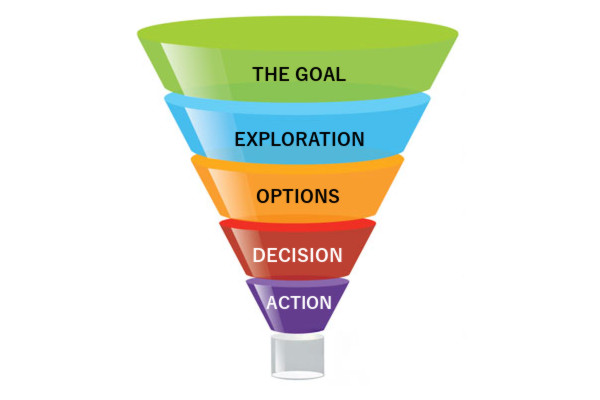The Coaching Funnel is a model of a coaching dialog which allows sufficient time on the front end to explore a situation before generating options and actions. It begins with a narrowly focused goal to help determine an ultimate objective. After establishing “the goal” the process goes on to open questions which allows for further exploration into what’s going on in the situation both externally and internally. Getting more data helps generate potential solutions to the problem. Then the conversation begins to narrow again. Options are evaluated and a course of action is decided on. The funnel ends when specific steps of action to move towards the goal are chosen.
Step One: The Goal
The goal is a one-sentence statement of the objective the person wants to reach by a particular date. Stating an objective in one short sentence is valuable, allowing you to return frequently to a clear, succinct statement staying focused on a single objective.
Step Two: Exploration
Once a goal is set, it’s time to fully explore the situation. Exploration can involve probing both the external situation and the client’s internal responses to what is happening. This phase is about data collection so that the great decisions can be made in the final three steps.
Step Three: Options
In this step, the process calls for creatively developing multiple potential solutions. Often the first several ideas are ones that the person has already considered; the process becomes is powerful because better decision are made when you maximize the available options. For more on this read the Heath Brothers’ great book Decisive: How to Make Better Choices in Life and Work
Step Four: Decision
The fourth step is to make a decisive choice to pursue a certain course of action that moves towards the goal established in Step One. In this step a decision on which potential solution to pursue is made, and a firm commitment to put this choice into action.
Step Five: Action
This step is about the action plan. Each action step in the process should have high buy-in. Verbalizing and articulating what will be done creates accountability and commitment.
For coaches looking for great questions to ask to facilitate these five steps check out the book Coaching Questions: A Coach’s Guide to Powerful Asking Skills
